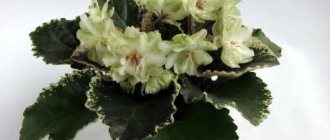Brief descriptions of some other varieties
The particularly delicate shade of “Jewels of Neptune” is most reminiscent of the iridescent aquamarine colors of the paintings of Ivan Aivazovsky. It is worth noting that this variety is a chimera, so gardeners must be very careful when transplanting and propagating it so as not to disturb the varietal characteristics. The variety blooms with large, grooved, white flowers with blue stripes.
Warm Sunshine is a semi-blooming senpilia that blooms with pale yellow stars. The leaves are simple, spoon-shaped, dark green.
Violet Anna Pavlova is a profusely blooming, densely double, wavy star with a pink tint along the edges of the petals.
Unlike all the previous ones, White Bear has a dazzling, snowy inflorescence and huge, spherical, swollen flowers.
In general, the white range of the violet family includes many plants that are both snow-white and have a variety of undertones and shades.
So connoisseurs of brightly colored Saintpaulias will have a difficult choice for their home greenhouse. And the photos and names of violets with white flowers presented in our article will help you in this difficult matter.
White violet: description of growing the plant
Planting material
If you decide to grow white violets at home, you should choose the required plant variety. It is necessary to buy planting material only in special hardware stores to avoid counterfeiting. To avoid being deceived, you should pay attention to several factors.
The leaves should be a rich dark green or light green color. At the same time, there should be no stains on it. In addition, you should pay attention to the length of the cuttings, and if their size is excessive, it is best not to buy such a plant, since this indicates the plant’s weak immunity and unsuitable growing conditions.
The rosette should be quite dense, and if the plant has a very dense rosette, this indicates a possible plant disease. The optimal time to purchase a seedling will be the spring months, since in other seasons the plant does not tolerate transplantation well and will slowly undergo the adaptation process.
Rules of care
In order for the plant to fulfill its decorative functions, it is necessary to follow the rules of care, as well as know some of the characteristics of the crop variety.
The soil for white violets must be carefully selected. The optimal composition will consist of garden soil with the addition of sand. At the same time, one should not forget about a fairly thick layer of drainage, for which expanded clay is perfect. If you create the necessary conditions for the growth of a plant, it will thank you with lush, beautiful flowering.
You should pay close attention to the lighting in the room, since violet reacts extremely negatively to a lack of sun, but direct exposure to scorching rays will also have a negative impact on the plant. Therefore, when daylight hours are short enough, it is necessary to purchase special lamps for artificial lighting.
In addition, the plant needs to be regularly watered and fed in order for it to look impressive. In addition, systematic pruning is needed. The humidity level of the room in which white violets are grown should be about 50% or higher.
white violet: “white queen”
Temperature
The optimal temperature for normal growth and development of the plant will be approximately 20 - 22 degrees. In this case, sudden temperature changes and drafts should be avoided, since the plant cannot tolerate these conditions. If the room is too hot, for example 30 degrees, then the leaves of this plant will lose their rich color, and the flowers will no longer be so lush and numerous. If the temperature is too low, the roots may rot.
Feeding
Like any plant, violet requires regular feeding. It is necessary to add the necessary medications on time: amino acids, vitamins and microelements. It is best to use a fertilizer mixture specially prepared for violets. The optimal regimen will be approximately 2 times every 7 days. However, you must follow the rules specified in the instructions. Experienced gardeners recommend not feeding the violet after you have transplanted it, or if there are frequent changes in air temperature.
Watering
You need to water the white violet very carefully, since the plant can die either from an excess of moisture or from a lack of it. As a rule, watering is performed approximately twice every 7 days. The water should be warm and pre-settled. You can add water not directly under the roots, but it is better to pour it into a fairly high tray in which the pot with the plant is placed, and the soil is already saturated through the lower holes. Excess moisture is drained away. Foliar spraying of plants is acceptable. In this case, you should not get on the flowers themselves.
Diseases and pests
If the necessary conditions are not met, the plant may be affected by diseases. Powdery mildew, rust, late blight, and gray rot are popular.
It is quite easy to detect powdery mildew by the white coating that appears on the leaf blades. If you notice signs of the disease, you should treat the plant with foundationazole or another product.
If you see gray spots on the plant, it means that the plant has been affected by gray rot. In this case, it is necessary to transplant the plant into new soil, and also treat the bush with a fungicide.
If the violet is affected by diseases such as late blight and rust, then the plant should also be replanted and the necessary preparations should be used. It is best to take preventive measures rather than treat the plant. To do this, you should periodically treat the plant with a solution of copper sulfate and replant it in a timely manner.
In order for the bush to look impressive, pruning should be carried out systematically, forming a three-tiered structure of the plant. Also, during pruning, it is necessary to get rid of the yellow lower leaves. In this case, the young rosette should be left untouched. If a large number of stepsons have formed on the plant, it is recommended to cut them out or pull them out, since they interfere with the root system receiving air and light.
Reproduction
Several methods of propagation are suitable for white violets, namely cuttings, peduncles, seeds and stepsons.
The easiest way to propagate the plant is using leaf cuttings. To do this, you should select the healthiest, strongest leaf of sufficiently large size from an adult bush and cut it at an angle, using a sharp, clean, disinfected knife. The cutting is placed in a glass of water or in soil so that it takes root properly.
You can place the leaf in an ordinary plastic glass, where a layer of drainage will be laid out and the same soil will be selected as for an adult plant. It is necessary to make a suitable depression in the soil and fill it with moss so that the cuttings take root faster. Next, after planting the cutting, it must be watered with warm water, preferably boiled, and covered with some kind of transparent cover, thereby creating greenhouse conditions. You can use a plastic bag. The temperature in the room where the cuttings are rooting must be at least 22 degrees. Next, the cutting is cared for as usual, as for an adult plant.
In addition, you can place the leaves in a glass of water, and here the roots will begin to grow quite quickly. Within a week you will be able to see them, and after they have grown more than 1 cm, you can already place the plant in a pot with soil and a drainage layer. After planting the cutting, it is necessary to properly care for it and protect it from direct sunlight and drafts.
Plants are also often propagated by stepsons, which are taken from an adult healthy plant and placed in the required soil. With this propagation method, you can be sure that the bush will grow exactly the same as an adult plant.
Seed propagation requires quite a lot of effort and time from the grower, since it will be necessary to pollinate two bushes: male and female. To do this, the plant is placed nearby and, if necessary,
artificial pollination is used. If pollination has occurred, then a box with seeds is formed, which should be dried for some time, and then the finished seed should be collected. You can also buy seeds in bags in specialized stores.
Peculiarities
Flowers of the described variety are usually not specially bred, but compositions are formed from them as needed. Some gardeners prefer to leave a single growing point, and the rosette hangs quite impressively on a rather long stem. Others, on the contrary, plant several heads in one container, removing the stepsons, and eventually get a spherical flower. Saintpaulia Angel forms quite numerous inflorescences on a relatively long stem that do not hang over the edges of the pot.
The young shoots of Saintpaulia should be dense, so that later thinning will provide access to light to the weaker stepsons.
They bloom for up to ten months a year with a short rest break. In order for the inflorescence to be abundant and not fall off for as long as possible, you need to keep them in a smaller pot and in bright light for up to fourteen hours a day. If the Saintpaulia rosette is formed correctly, then it does not allow the leaves to grow widely. When watering Angel violets, you should not moisten the soil too much - this leads to its rotting, and the leaves, on the contrary, begin to wither.
Short young leaves are not suitable for propagation of Angels. They take root well in water or in peat humus tablets. Keeping Angel violets guarantees its owners the enjoyment of bright and beautiful flowers almost all year round, because Saintpaulias need to be replanted twice a season, regardless of age.
Rules for growing white violets
White violet is very popular. Almost every gardener grows it at home, since this plant is not difficult to care for. In addition to the fact that violets are grown in apartments, they often become the subject of admiration in various public gardens,
gardens and parks. In order for the plant to fulfill its decorative functions, the following rules must be followed.
Firstly, it is necessary to form a beautiful rosette shape in order for the plant to have a more impressive appearance. To do this, you can simply rotate the flower around its axis. It is also necessary to ensure that the plant has a neat size. Trim protruding leaf blades or remove lower foliage. As a result of this pruning, a bush is formed that looks like a small bouquet with a lot of green leaves and white flowers.
white violet: white pearl variety
In addition, the plant must be periodically rejuvenated and propagated to continue its appearance. Once the stem has grown to its optimal size, it should be cut off. This will stimulate the growth of new young leaves. You can also rejuvenate an old plant by replanting it in a new container. You can replant the entire plant. Or you can take part of the roots with leaves.
Experienced flower growers note that if the violet is constantly watered with a weak solution of manganese, the inflorescences change their snow-white hue to another unusual color.











